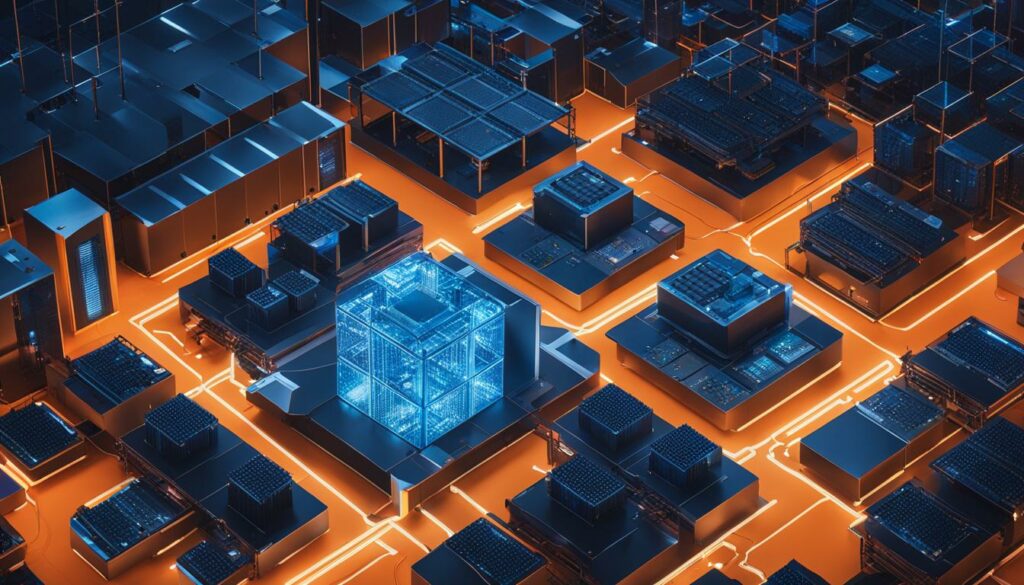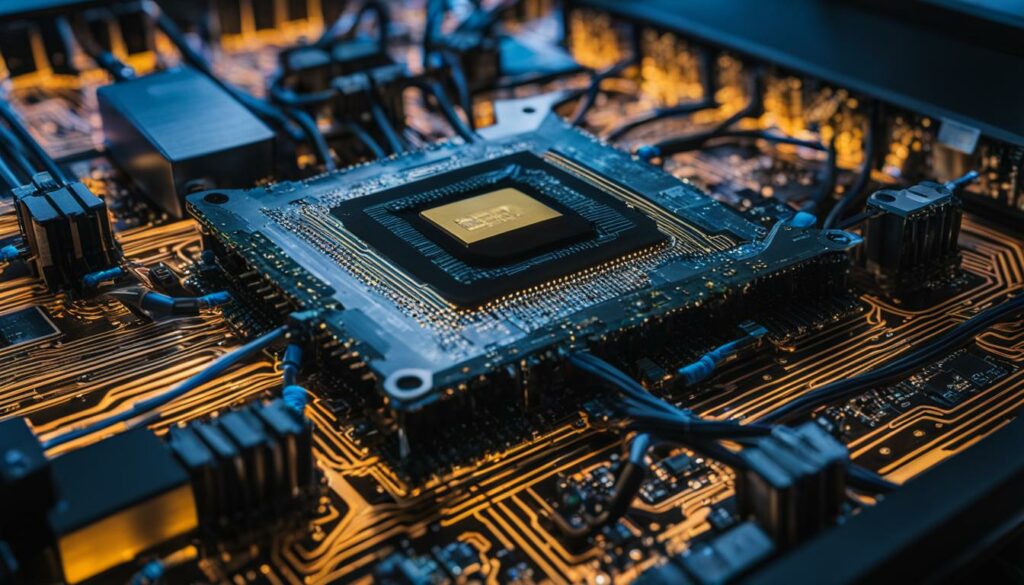Welcome to the world of edge computing in web hosting! In today’s digital landscape, where speed and performance are paramount, edge computing has emerged as a game-changer. By bringing computation and storage closer to the source of data generation, edge computing revolutionizes the way web hosting services operate.
With traditional cloud hosting, data processing happens in centralized servers located far away from end users. This often leads to latency issues and slower response times. But with edge computing, the processing power is distributed across edge devices, edge servers, and edge data centers, strategically positioned at the network’s edge.
By optimizing data processing at the edge, you can significantly reduce latency, optimize bandwidth usage, enhance security, improve scalability, and support real-time applications. Whether you’re in the e-commerce industry, running content delivery networks (CDNs), or gaming online, edge computing can take your web hosting performance to the next level.
However, like any technology, edge computing comes with its own set of challenges. Infrastructure complexity, data governance, and standardization are areas that need careful consideration. But fear not, as we delve deeper into this article, we’ll explore these challenges and show you how the future of edge computing in web hosting is shaping up.
Key Takeaways:
- Edge computing brings computation and storage closer to the source of data generation, enhancing web hosting performance.
- Advantages of edge computing include reduced latency, optimized bandwidth usage, enhanced security, improved scalability, and support for real-time applications.
- Edge computing finds applications in content delivery networks (CDNs), IoT devices, 5G networks, e-commerce, and online gaming.
- Challenges related to infrastructure complexity, data governance, and standardization need to be addressed for wider adoption of edge computing in web hosting.
- Future trends include machine learning at the edge, blockchain integration, and the emergence of Edge-as-a-Service (EaaS) models.
Understanding Edge Computing in Web Hosting
Edge computing is a key component of modern web hosting, revolutionizing the way data is processed and delivered. It operates on a distributed computing paradigm, where data processing occurs closer to the point of data generation, reducing reliance on centralized cloud servers. This decentralized architecture brings computation and storage resources to the network’s edge, offering a range of benefits for end users.
Edge devices, such as IoT devices, routers, switches, and smartphones, act as computing nodes that process data at the edge. They play a vital role in bringing computation capabilities closer to users, enhancing performance and reducing latency. Specialized edge servers further optimize this process by handling computing tasks near the user. These servers efficiently manage data processing and deliver faster responses, ensuring a seamless user experience.
Another crucial element in edge computing is the presence of edge data centers. These centers serve as localized hubs for processing and storing data, minimizing the need for data to traverse long distances to reach centralized cloud servers. By eliminating the latency associated with long-distance data transmission, edge data centers significantly enhance the speed and responsiveness of web hosting services.
The decentralized architecture of edge computing, supported by edge devices, edge servers, and edge data centers, brings numerous advantages to web hosting. It enables faster response times, reduced latency, and improved performance, creating a more efficient and responsive digital experience for users.
Advantages of Edge Computing in Web Hosting
Edge computing in web hosting offers numerous advantages that enhance performance, optimize bandwidth, and provide real-time capabilities. By leveraging edge computing technology, you can revolutionize your web hosting experience and deliver a seamless digital experience to your users.
Faster Response Times and Reduced Latency
Edge computing allows data processing to occur closer to the point of origin. By bringing computation and storage closer to your users, edge computing significantly reduces latency, resulting in faster response times. With reduced latency, your website or application can deliver content and services with exceptional speed, providing an improved user experience. Whether it’s loading web pages or processing transactions, reduced latency is crucial for attracting and retaining satisfied users.
Bandwidth Optimization
With edge computing, you can optimize bandwidth usage and reduce strain on your network infrastructure. By minimizing the transmission of large volumes of data to centralized servers, you can save bandwidth resources and ensure efficient data transfer. This bandwidth optimization enables faster data delivery and ensures that your network operates smoothly even during peak traffic periods.
Enhanced Security and Localized Data Processing
The distribution of computing resources across the edge enhances security by reducing the attack surface. Edge computing allows local processing and securing of critical data, minimizing the risk associated with centralized data centers. By processing data locally, you can improve security measures, protect sensitive information, and ensure compliance with data governance regulations. This localized approach to data processing adds an extra layer of security and peace of mind for both you and your users.
Improved Scalability
Edge computing enables more efficient scalability in web hosting. Rather than relying on massive central infrastructure upgrades, you can add computing resources incrementally at specific edge locations. This flexible scalability allows you to cater to demand without the need for extensive infrastructure investments, ensuring that your web hosting can adapt to changing user needs and traffic patterns effectively.
Support for Real-Time Applications
Real-time applications, such as augmented reality (AR) and virtual reality (VR) experiences, require instantaneous responses. Edge computing’s ability to process data at the edge enables the seamless delivery of real-time applications. By leveraging the power of edge computing, you can ensure that your users have immersive and interactive experiences without any noticeable delays or lag.
Embrace the advantages of edge computing in web hosting to optimize your performance, enhance security, and deliver an exceptional digital experience to your users.

Applications of Edge Computing in Web Hosting
Edge computing offers a wide range of applications in web hosting, catering to diverse industries and enhancing user experiences. Let’s explore some of its key applications:
1. Content Delivery Networks (CDNs)
Content delivery networks leverage the power of edge computing to cache and deliver content from servers located closer to end users. By reducing latency and accelerating website and application loading times, CDNs ensure a smooth and seamless browsing experience. This is particularly crucial for businesses that rely on fast content delivery, such as media streaming platforms and e-commerce websites.
2. Internet of Things (IoT) Devices
The Internet of Things generates a vast amount of data through connected devices. Edge computing plays a vital role in providing real-time processing for this data, enabling quicker decision-making and minimizing the need for data to travel to centralized servers. This is especially significant in IoT applications that require immediate responses, such as smart homes, industrial automation, and healthcare monitoring systems.
3. 5G Networks
The rollout of 5G networks enables high-speed data transfer rates, making it an ideal complement to the capabilities of edge computing. By leveraging edge infrastructure, businesses can take advantage of the low-latency environment offered by 5G and ensure seamless user experiences. This opens up possibilities for real-time applications, such as augmented reality (AR) and virtual reality (VR), which heavily rely on fast and reliable data processing.
4. E-commerce
Edge computing plays a crucial role in enhancing the performance of e-commerce platforms. By bringing computation and storage closer to end users, it significantly reduces latency and optimizes user experience. Faster page load times and seamless transaction processing contribute to increased customer satisfaction, improved conversion rates, and overall business growth.
5. Online Gaming
Online gaming demands low-latency environments to ensure a smooth and immersive gaming experience. Edge computing provides the necessary infrastructure to process gaming data closer to the players, minimizing delays and eliminating lag. This results in a more responsive and enjoyable gaming session, enhancing player engagement and satisfaction.
These applications highlight the versatility and impact of edge computing in web hosting, revolutionizing industries and enabling businesses to deliver exceptional digital experiences to their users.
Challenges and Considerations of Edge Computing in Web Hosting
While edge computing brings numerous benefits to web hosting, there are challenges that need to be addressed. Implementing edge computing requires a more intricate infrastructure with distributed nodes, leading to increased complexity. Organizations transitioning to this paradigm must manage this complexity effectively.
Edge computing also raises concerns related to data governance and compliance, particularly when processing sensitive information locally. Ensuring adherence to regulations becomes a critical consideration.
Furthermore, the lack of standardized practices and interoperability among edge computing solutions poses challenges for seamless integration and collaboration across diverse platforms.
Key Challenges of Edge Computing in Web Hosting:
- Infrastructure Complexity – Implementing edge computing requires a more intricate and distributed infrastructure, which can be challenging to design, deploy, and manage effectively.
- Data Governance – Processing sensitive information at the edge raises concerns about data privacy, security, and compliance with regulatory frameworks.
- Standardization and Interoperability – The lack of standardized practices and interoperability among edge computing solutions can hinder seamless integration and collaboration across different platforms and systems.
Overcoming the Challenges:
Addressing the challenges of edge computing in web hosting requires careful planning and effective strategies. Organizations can:
- Invest in robust infrastructure management and monitoring tools to handle the complexity of distributed nodes and ensure smooth operation.
- Implement secure data governance frameworks and compliance protocols to protect sensitive information processed at the edge.
- Encourage industry-wide collaboration and standardization efforts to promote interoperability and seamless integration of edge computing solutions.
Effective management of infrastructure complexity, data governance, and standardization will pave the way for the full realization of edge computing’s potential in web hosting.
Benefits of Addressing the Challenges:
By overcoming the challenges of edge computing in web hosting, organizations can unlock the following benefits:
| Benefits | Description |
|---|---|
| Optimized Performance | Efficiently managing the infrastructure complexity leads to improved performance, reducing latency and enhancing user experience. |
| Data Security and Compliance | Implementing robust data governance practices ensures the secure processing of sensitive information, complying with regulatory requirements. |
| Interoperability and Collaboration | Standardizing edge computing practices allows for seamless integration and collaboration across diverse platforms, enabling enhanced functionality and scalability. |

Addressing the challenges of infrastructure complexity, data governance, and standardization in edge computing is crucial to unleashing its full potential in web hosting. By managing complexity, ensuring data security, and promoting interoperability, organizations can harness the benefits of edge computing to enhance performance, adhere to regulatory requirements, and enable seamless collaboration.
Future Trends and Innovations in Edge Computing for Web Hosting
As the realm of web hosting continues to evolve, edge computing is set to drive future trends and innovations in this space. With the integration of machine learning at the edge, devices can now perform real-time data analysis, enabling them to make instant decisions without relying on centralized cloud servers. This advancement not only improves the speed and efficiency of data processing but also enhances the overall user experience.
Another exciting trend in edge computing for web hosting is the integration of blockchain technology. By securing transactions and data at the edge, blockchain ensures the integrity and immutability of information in a distributed computing environment. This innovation brings an added layer of trust and security to web hosting, giving businesses and users peace of mind.
Furthermore, the emergence of Edge-as-a-Service (EaaS) models is set to revolutionize the accessibility of edge computing resources. With EaaS, businesses can leverage the benefits of edge computing without the need for extensive infrastructure investments. This democratizes access to edge computing capabilities and paves the way for wider adoption across industries.
With these promising trends and innovations, the future of edge computing in web hosting is bright. Machine learning at the edge, blockchain integration, and the rise of EaaS models are reshaping the hosting landscape, offering improved performance, enhanced security, and greater accessibility. Embracing these advancements will undoubtedly elevate the digital experience for businesses and users alike.

| Trend/Innovation | Description |
|---|---|
| Machine Learning at the Edge | Real-time data analysis and instant decision-making capabilities without relying on centralized servers. |
| Blockchain Integration | Securing transactions and data at the edge for enhanced trust and integrity. |
| Edge-as-a-Service (EaaS) | Democratizing access to edge computing resources, reducing infrastructure investments. |
Conclusion
Edge computing is revolutionizing web hosting dynamics by bringing computation and storage closer to you, the end user. With reduced latency and enhanced performance, edge computing enables faster response times and an improved digital experience. The benefits of edge computing in web hosting, including reduced latency, optimized bandwidth, enhanced security, improved scalability, and support for real-time applications, make it an invaluable technology for businesses.
The applications of edge computing in web hosting, such as content delivery networks (CDNs), Internet of Things (IoT) devices, 5G networks, e-commerce, and online gaming, showcase its versatility and impact across various industries. However, challenges relating to infrastructure complexity, data governance, and standardization need to be addressed for the full potential of edge computing to be realized.
Looking ahead, embracing future trends and innovations, such as machine learning at the edge, blockchain integration, and the emergence of Edge-as-a-Service (EaaS) models, will unlock the true power of edge computing in web hosting. The future of web hosting is undoubtedly being shaped at the edge, where speed, efficiency, and responsiveness converge to redefine the digital experience.
FAQ
Q: What is edge computing?
A: Edge computing is a distributed computing paradigm that brings data processing and storage closer to the point of data generation, reducing reliance on centralized cloud servers.
Q: How does edge computing work in web hosting?
A: Edge computing utilizes a decentralized architecture with computing resources strategically positioned at the network’s edge. Edge devices, edge servers, and edge data centers play key roles in processing and delivering data closer to end users.
Q: What are the advantages of edge computing in web hosting?
A: Edge computing offers reduced latency, optimized bandwidth usage, enhanced security, improved scalability, and support for real-time applications, resulting in faster response times and improved user experiences.
Q: In which areas of web hosting is edge computing applied?
A: Edge computing finds applications in content delivery networks (CDNs), IoT devices, 5G networks, e-commerce, online gaming, and other industries that benefit from low-latency environments and real-time processing.
Q: What challenges are associated with edge computing in web hosting?
A: Challenges include infrastructure complexity, data governance, and standardization. The distributed nature of edge computing requires effective management, while adhering to regulations and ensuring interoperability among solutions can be complex.
Q: What are the future trends and innovations in edge computing for web hosting?
A: Future trends include machine learning at the edge, blockchain integration for secure transactions, and emerging Edge-as-a-Service (EaaS) models that promote accessibility to edge computing resources. These innovations shape the future of edge computing in web hosting.
Q: How does edge computing impact web hosting dynamics?
A: Edge computing brings computation and storage closer to end users, resulting in faster response times, improved performance, and an overall enhanced digital experience.
Source Links
- https://www.linkedin.com/pulse/unleash-power-edge-computing-web-development-ln-techinfo-f1h3f?trk=public_post
- https://emailhosting.com/service/index.php?rp=/knowledgebase/462/The-Rise-of-Edge-Computing-Redefining-Web-Hosting-Performance.html
- https://technative.io/how-to-leverage-edge-computing-to-get-the-most-out-of-enterprise-iot-solutions/












